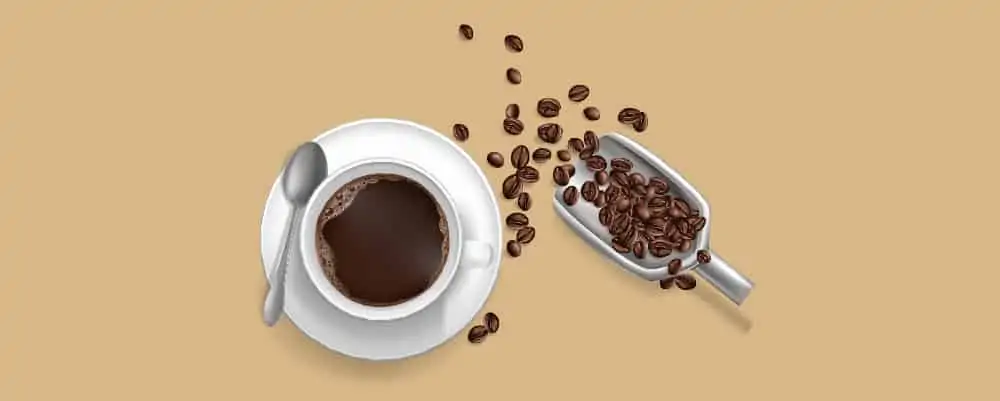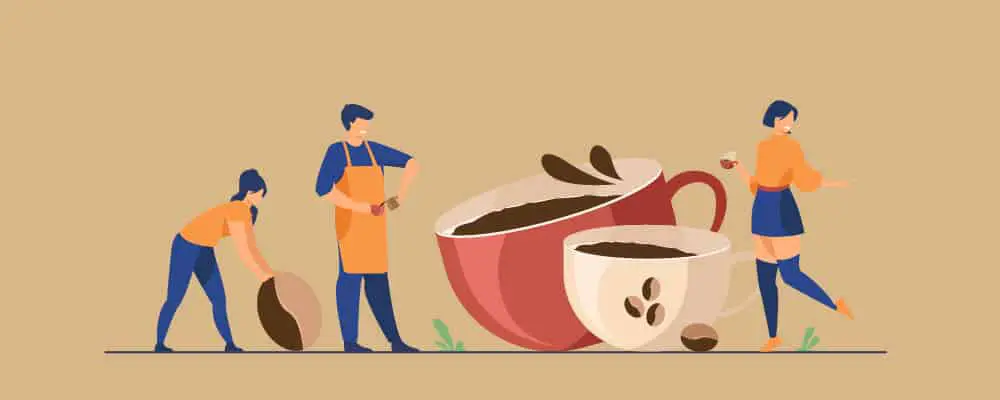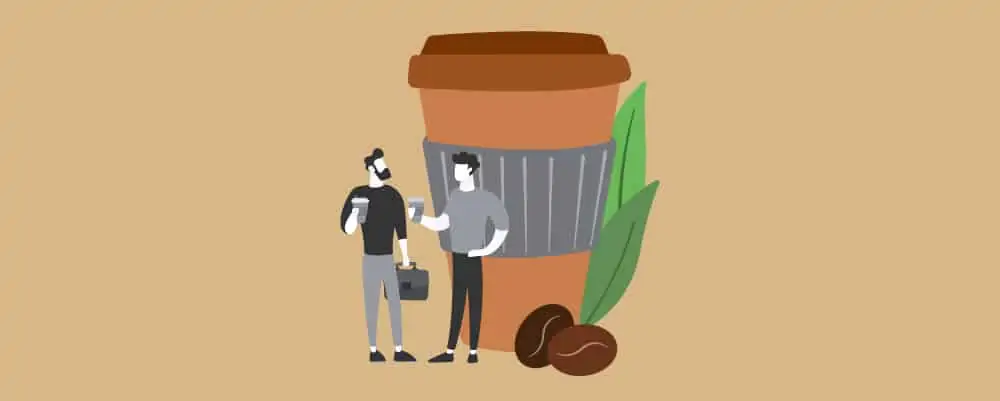
A thorough guide on the history of coffee; from when it was discovered to coffee consumption today.
Coffee is as essential to our culture as TV and good music. You’ll see it featured in every sitcom, find at least one coffee shop on every high street, and you’ll see global megastars advertising it. Being a coffee drinker is as much part of our cultural identity as which sports team we support.
If you don’t drink coffee personally then you will know a large number of people who do. It’s everywhere and hard to escape. It’s the second most popular drink in the world.
What is it about coffee that has us so fascinated?
It is hard to believe that 50 years ago you would have found very few coffee shops on the streets of the US. In fact, Starbucks (one of the biggest coffee chains in the world) is only turning 50 this year.
So, what happened that led to coffee being the 2nd most popular drink in the world?
Today, we’re going to delve into the history of coffee to find the answer to that question. Starting at its humble beginning and following the drink’s popularity as it spreads throughout the Middle East and across the rest of the world.
We will also be looking at how the way we brew coffee has changed over time. And how it became the 2nd most popular drink in the world.
‘Wherever it has been introduced it has found revolution. It has been the world’s most radical drink in that its function has always been to make people think. And when the people begin to think they become dangerous to tyrants’
–William Ukers
- Where Did Coffee Originate From
- When Was Coffee Introduced to the Middle East, Europe, and Beyond…?
- The Year that Changed Everything – 1869
- Evolution of Coffee
- Coffee Today
- Coffee Is The Second Most Traded Commodity In The World
- About 1.4 billion cups of coffee are drunk daily
- After Water, Coffee Is The Most Popular Drink Worldwide
Where Did Coffee Originate From

What we know as coffee beans are actually the roasted fruit of the coffee plant (scientific name Coffea). This plant has over 120 different species in its family.
Coffee beans grow on short bushes. They start their lives as white flowers before maturing into sweet, red berries. The berries are picked and roasted before being ground down and boiled to make the drink we know as coffee.
What Year Was Coffee Discovered
We do not know the exact year that coffee was discovered.
What we do know is that the coffee plant has been around for longer than humanity. The coffee plant is native to Ethiopia. And the earliest record we have of the humans harvesting the plant comes from one of the native tribes of the country.
The Oromo tribe reportedly ground up the fruit from the coffee plant and mixed it with animal fat to make a treat similar to modern day energy bars. These bars were reserved for fighters and scouts.
There are many legends that surround the discovery of this fruit’s secret powers. The most told story is about a group of dancing goats. This story is believed to have taken place between the 5-8th centuries ACE.
The story begins with a goat herder called Kaldi who was looking for a new place to let his goats graze. One day he took his goats to the edge of the coffee forests. While they were left unattended a group of his animals tucked into some of the sweet, red berries growing on a nearby plant.
Kaldi returned to find that his goats had gone mad. They were full of energy and bouncing around in a way that he had never seen before. As he was watching this, he saw another one of his goats sneak a red berry from the coffee bush. It wasn’t long before madness descended on this goat too.
Kaldi took a handful of berries for himself. Soon he too began to feel the rush of energy and awareness that came with eating the beans (Can You Eat Coffee Beans? – Should you Eat them?).
One day Kaldi’s farm was visited by a monk. They sat around the campfire together. Kaldi gave the monk some of his beans. The monk dropped the beans into the fire. After they took the beans out of the fire the monk ground them up, they added hot water – and coffee was born.
While this tale points to the origins of coffee, the first official records we have of the drink come from its neighboring country Yemen.
Who Invented Coffee?
At the start of the 5th century, Ethiopia traveled across the water and invaded the country of Yemen. They brought their magical beans with them. It was at this time that Sufi mystics adopted coffee.
It is these mystics that we have to thank for many of our modern coffee habits.
In the port city of Mocha, records were found of Sufi mystics roasting and drinking coffee beans to help them stay up for all night prayer sessions. From then on drinking coffee to aid enlightenment became common practice in a few religions.
It was also in Yemen where the first strains of Coffea Arabica were bred.
There are two main breeds of coffee (but there are over 120 in total) – Coffea Arabica and Coffea Robusta (or Canephora). Robusta beans are very bitter but their plants are a lot hardier than Arabica bushes. Coffea Arabica is still the most popular type of coffee, with over 60% of the coffee produced yearly being made up of this strain.
As the population of Yemen was mostly Islamic coffee’s popularity picked up very quickly. It offered an interesting alternative to the forbidden alcoholic beverages. That’s not to say that the drink was always popular with religious bodies.
When Was Coffee Introduced to the Middle East, Europe, and Beyond…?

Does a Latte Contain Coffee? Or, is there Espresso in a Latte?
The history of coffee began in Africa, however, it doesn’t end there. Let’s take a look at the series of events that lead to coffee becoming a truly global phenomenon.
Coffee in the Middle East
Once coffee had crossed from Ethiopia to Yemen, it was not long before it had been adopted by the Sufi mystics.
However, coffee soon became popular with the general public.
Yemen’s Islamic population became very fond of the drink as it could be shared with friends in a similar way that beer was in Europe. It quickly became the drink of choice for religious men in the region.
Cafes serving the drink began to pop up across the country. They filled the same food in a society that pubs did in places like France and the UK. After long days of working and late night prayers, the Muslim men would relax in these cafes and discuss topics like theology, business, and philosophy.
Women were not allowed in these cafes, however, they were allowed to drink coffee at home.
In the 6 and 7th centuries, the popularity of coffee spread across the majority of the Middle East. It became so entrenched in the culture that laws were affected by it. Most notably, a law was passed in Turkey during the 7th century that stated a woman had the right to divorce her husband if he did not provide her with at least one cup of coffee a day.
Coffee remained the most important beverage in the region for the next 10 decades.
In the 16th century, the Turkish Ottoman empire came into power. They began to export coffee to the countries of Europe – most notably England, The Netherlands, and France (in 1669).
At this point, the Turkish had a monopoly on the coffee industry and as Europeans became more entranced by the drink they began to raise prices. This resulted in the big empires of the time (the French, Dutch, British, and Spanish) setting out to discover new parts of the world where they could grow their own coffee.
Meanwhile, while the Turkish Ottomans were shipping coffee out to Europe they began to grow weary of the power it was having on their citizens. As did the leaders of other countries across the region.
The main concern was that excessive consumption of the drink was leading to their populations becoming too educated and enlightened. ‘And when the people begin to think they become dangerous to tyrants’ – William Ukers.
Many ruling parties tried to ban coffee and were met with widespread opposition. Once Ottoman suffered such severe backlash to the attempted ban that he was forced to open the coffee shops again, almost immediately.
Coffee has been banned by many governments throughout its long and violent history. It has been banned by governments and religious organizations alike. There was in fact a time when coffee was simultaneously banned in both Mecca and Constantinople.
The only faintly successful ban on coffee took place in Mecca during the 16th century. However, the ban led to a large underground scene of illegal coffee houses developing. These rings operated successfully until the ban was lifted a few years later.
To this day, coffee is still the most popular drink (besides water) in the Middle East.
What is a Cortado Coffee? How is it different from a Latte or Flat White?

Flat White vs Cortado – What is Different with these Espresso Drinks?
Coffee in Europe
The story of coffee takes a darker turn after the drink was introduced to the Europeans by the Turkish Ottoman Empire.
In the middle ages, the average European drank 100 liters of beer a year. Their water was not safe to drink and the consumption of beer saved many thousands of lives. However, it did reduce productivity and increase violence levels in the region. Coffee offered a perfect solution to this problem.
The Brits were the first nation to succumb to coffee fever. They were introduced to coffee in the early 17th century. In the 32 years between 1672 and 1700, over 2000+ coffee shops were opened in London alone.
The East India Trading Company, Lloyds Bank, and the London Stock Exchange all started as coffee shops.
Eventually, these coffee shops began to be known as Penny Universities. These cafes were frequented by the brightest minds in London, and common men could listen to them debate each other for the price of a cup of coffee – a penny.
The monarchy at the time was alarmed by how taken by the drink the British were. Charles 2nd was worried that these cafes would lead to a second revolution. However, like many leads before him, his attempt to ban the drink was unsuccessful – How to Grind Coffee Beans Without a Grinder
Things didn’t go so peacefully across the English Channel, however.
Coffee’s connection to the French Revolution is a little known secret. This revolution led to many changes across the world. With results like this, you can understand why so many world leaders were worried about the effects of the drink.
France was famously unimpressed by coffee when it was first introduced to Paris in 1669. However, it is said that when the French discovered that coffee was an efficient laxative they became enamored with it.
Cafes soon became so trendy in the country that anyone who was anyone could be seen frequenting them. Two notable figures included the philosopher Voltaire and the American Revolutionary Benjamin Franklin.
During the 18th century, France had been pushed into an economic crisis by its monarchy. While peasants starved on the streets their rulers sat in gilded palaces and indulged in feasts. Anger was brewing amongst the working class.
Soon they began to plot revolutions in their cafes. The coffee shops were so crucial in the early stages of the revolution that Victor Hugo chose to set the revolutionary headquarters in Les Miserables in a coffee shop. It is also believed that what Benjamin during this time inspired him to start his campaign for American Independence.
One of the most important moments that was a catalyst for the revolution, The Storming of Bastille, was planned in a cafe. Two days earlier Camille Desmoulins led the meeting on July 12th.
The French Empire ended up being heavily invested in the coffee industry. At one point they were in possession of the majority of the coffee in the world. However, one of their colonies in the Caribbean broke away from them and caused them to lose the majority of their crops – French Roast vs. Italian Roast Coffee – Bold and Dark Roasted Beans
The first coffee plant that was taken to the Americas by France arrived on a boat with a French explorer and a large number of slaves. They landed on Martinique. Within 50 years 18 million coffee plants were grown on the island, making up 50% of the coffee produced in the world at the time.
As you will see in the next section, the majority of the coffee industry was built on the back of slaves. This was something that enraged many people around the world, not least the slaves who were dying to grow the crop.
The Haitian Revolution took place between 1791-1804 and was incredibly bloody. After 13 years of fighting the revolutionaries were victorious. Haiti declared independence and became the first republic in the Caribbean.
The revolution resulted in the death of 200,000 Haitians, 45,000 British fighters, and 75,000 Frenchmen.
The revolution put an end to France’s domination of the global coffee market. The Colonies of Portugal and Spain in South America began to produce more coffee to fill the void left by Haiti’s Independence war.
To this day, Coffee is still a key part of European culture – particularly cafe culture. With countries like Italy, Finland, and Denmark being some of the biggest coffee drinkers in the world – French Press vs Pour-Over Coffee – Are They The Same?
In the UK the loss of most of their coffee plants in South Asia led to them adopting tea as their national drink. However, coffee is still popular in the country. Although, thanks to their poor weather conditions, cafe culture is not so integral to them. They still have a thriving pub culture but all the major coffee chains have shops in the UK.
In the early 20th century the espresso machine was invented in Italy. It slashed the brewing time of coffee from 5 hours to 30 seconds. Making it possible to serve coffee to vast numbers of people at once.
Later in the 20th century, a Vancian cafe invented the Cappuccino. They did this by adding milk and sugar to their bitter coffees. It was named Cappuccino after the color of Capuchin monk’s robes.
Most of our coffees have Italian names because of this development. The most notable exception being Mochas which are named after the port city in Yemen where coffee was supposedly first brewed.
Coffee comes to the Americas
After his experience of coffee shop revolutions in France, Benjamin Franklin returned to the soon to be the United States with a big dream.
The founding fathers plotted their revolution in coffee houses. And after this drinking coffee became seen as a patriotic act. It was seen as a slight to those tea drinking Brits. Its popularity surged – Ultimate Comparison of Pour-Over vs Drip Coffee – Which Tastes Better?
Coffee began to gain popularity, but America’s love for the bean really exploded during the First World War. Coffee was included as an essential part of the troops’ rations. During World War 1 it was estimated that the US Army drank over 40 million cups of the stuff a day.
Many Dutch and Italian (Illy vs. Lavazza – Which Italian Coffee Is Better?) immigrants brought their love of coffee and cafe culture with them to the states. Coffee shops began to pop up all over the country.
Coffee began to boom again after the invention of instant coffee. Bitter Robusta beans were roasted, brewed, and freeze-dried (Can You Freeze Brewed Coffee?). The frozen stuff was then broken down into little granules. These granules could next be dissolved in hot water to create a bitter cup of coffee with little to no effort.
Not only did instant coffee offer an easier way for Americans to make coffee but it also meant that cheap coffee was available. This was the first time that working class Americans could afford to buy coffee. From then on coffee became something you drank at home, or by the gallon at dinners. Coffee was not seen as cool or as a cultural movement, but as a basic enmity.
All of that changed when two friends opened the first Starbucks store in Seattle in 1971. By the time Howard Schultz took over in 1982, they had opened three other stores. Schultz had previously visited Italy and had a vision of bringing Italian coffee culture to the streets of the US – Which Is the Strongest Coffee at Starbucks?
They started by roasting their own coffee beans and building stores that looked like the ones Schultz had seen in Italy. As they offer coffee that was a lot higher quality than any instant coffee available in grocery stores, Starbucks quickly became the biggest coffee store in the US – What is Espresso Crema? How to Make Espresso with Crema?
Soon they would be opening stores all over the world. In 2012 Starbucks claimed that they were serving over 80 million customers a week from 65 different countries. The company is currently estimated to be worth around $80 billion – Americano vs Latte – What Are The Differences?
The Year that Changed Everything – 1869
1869 is arguably one of the most important years in the history of coffee. During this year, two major events occurred that changed the way the world drank coffee.
The first event was a disaster. A disease called Rust Leaf broke out in the South Pacific. This disease ended up killing nearly all of the Coffee Arabica in this region – Arabica vs Colombian Coffee: What are the Differences?
Many of the major empires lost a huge amount of money over this summer. Most notably, the British Empire who lost most of their coffee plantations. Many believe that this was the year that led to the UK investing so heavily in tea. A drink that is now so inseparable from their national identity.
The second event was an important discovery. As most of the world’s supplies of Arabica were dying off another strain of coffee was discovered. In the home of coffee, Ethiopia, Coffea Robusta was discovered – Arabica vs Robusta Coffee Beans – What Is the Difference?
Robusta was resistant to the majority of plant diseases and grew a lot quicker than Arabica. Many believe that it would soon replace Arabica as the coffee bean of choice. However, Robusta suffered from one issue – it does not taste good. The bean makes a bitter brew that is now used to make the majority of instant coffee blends.
Evolution of Coffee
Long Black vs Americano Coffee – Are they the same or different?

We are now going to look at how the way we brew coffee has changed over time. Now we are lucky enough to be able to choose between using Espresso machines, cafeterias, and french presses (French Press Coffee vs. Espresso). However, coffee lovers weren’t always that lucky.
When Was The First Cafetiere In The World Created?
The Cafetiere (or French Press [Moka Pot vs. French Press – Which Coffee Tastes Better?]) first appeared in France in the mid 19th century. However, the first patent was put in by an Italian man in 1933. It is hard to get our heads around the fact that the Espresso Machine is older than the French Press.
The French Press is made up of a glass body, steel (or now plastic) lid, with a plunger. On the inside of the plunger, there is a reusable coffee filter that collects the grounds and prevents them from falling into the cup.
The French Press made it possible for workers to brew high-quality coffee grounds at home in a short amount of time – Percolator vs French Press: Which One to Choose to Brew your Coffee?.
The trick to this was that the French Press uses a lot more coffee grounds (Best Coffee Grind for French Press?) than previous methods did. A single cup brewed in a French Press requires at least 3 tablespoons of coffee grounds.
When brewed over a long period of time only a single tablespoon of grounds is required. However, this method of brewing coffee worked well when making the newly invented Cappuccino (Dry vs Wet vs Bone Dry Cappuccino – What are the Differences?) which used milk and sugar (How Is Caffeine In Coffee Affected By Sugar And Cream?) to cover up the taste of the bitter beans (How to Brew Low Acid Coffee for Upset Stomachs).
When Did We Start Brewing The Coffee?
When it was first discovered in Ethiopia, coffee was originally mixed with fat to create an energy bar for warriors. Some say that coffee beans were also roasted and brewed in Ethiopia. However, the first records we have of this taking place suggest coffee was first brewed in Yemen.
Yemen was invaded by Ethiopia in the 5th century. We have records of Sufi mystics using the brew to keep themselves awake while praying.
When was the Espresso Machine Invented?
The Espresso Machine was first put on sale in 1903, by a man called Angelo Moriondo. There are a few similar patents that were registered in Italy at the same time, but Moriondo was the first man to get it on the market.
This machine used high pressure, boiling water to brew its coffee. Before this machine was invented, it took around 5 hours to properly brew coffee beans. Thanks to the Espresso Machine (How to Use a DeLonghi Espresso Machine) the task only takes 30 seconds now.
Once the machine became available it became possible for cafes to make a much larger profit. As they could now brew a lot more coffee every day. They also wasted less coffee as it could be made a cup at a time rather than in big batches.
When Did Coffee Become Popular?
Coffee first became popular in the Middle East during the 5-6th centuries. It was very popular there because the Islamic communities didn’t drink alcohol. They found it an enlightening and stimulating drink that made it easier to stay up for all night prayers.
The drink was then introduced to Europe. It first became popular in the UK, where the British went completely mad for it. They opened over 2000+ cafes in London over a 32 year period. It then swept across the rest of Europe and Scandinavia. Where it still remains incredibly popular.
The invention of the Espresso Machine (Pump vs. Steam Espresso Machine) and instant coffee made it easier for the masses to access.
During WW1 coffee became extremely popular in America. However, things reached new heights after the opening of places like Starbucks in the ’70s.
Coffee Today

Coffee has a wild history, featuring revolution, meditation, slavery, and disease. But against all odds, the coffee insidery is still thriving today – with chains like Starbucks serving over 80 million customers a week.
In this final section, we are going to look at what the world of coffee looks like today.
Coffee Is The Second Most Traded Commodity In The World
Coffee is the second most traded commodity in the world right now. The Global Industry is worth around $465.9 billion.
Over a third of this coffee is produced by one country – Brazil. They have been the world’s leading coffee producers for over 150 years.
Brazil began this dominance when slavery was still legal. The industry heavily relied on the work of slaves until the practice was abolished in 1888. At this point over 10% of Brazil’s population were slaves.
Brazil produces well over 60% of the world’s Robusta crops and therefore has a huge stake in the instant coffee market – What Is the Difference between Instant and Ground Coffee?.
Some of the best coffee in the world comes from Costa Rica. This country takes its coffee very seriously. So seriously, in fact, that the growing of Robusta beans is banned on the island.
Costa Rica is one of the few happy stories when it comes to the history of coffee. When the Spanish arrived on the island they slaughtered too much of the population to have slaves man their plantations. Instead, the land was divided and given to local people.
Many of these families still farm the same land today. Costa Ricans believe that their island is sacred and they have approached the task of growing coffee in a way that isn’t detrimental to the local fauna and wildlife.
About 1.4 billion cups of coffee are drunk daily
America makes up 400 million of these daily brews. Averaging out at 3.2 cups per day per person.
America doesn’t even make it into the top 10 of per capita coffee drinking countries. The list is dominated by the Scandinavian countries and features a surprise appearance from Canada at number 10.
After Water, Coffee Is The Most Popular Drink Worldwide
Coffee is far more popular than any other man-made drink in the world. It far outsells tea, Coca-Cola, and beer. It is the most popular drink in most countries as well.
The country that drinks the most coffee per capita is Finland. 15% of the men in Finland (and 10% of the overall population) drink more than 10 cups of coffee a day.
In America, we drink over 146 million cups of coffee a year and over 64% of our population has at least one cup a day.
